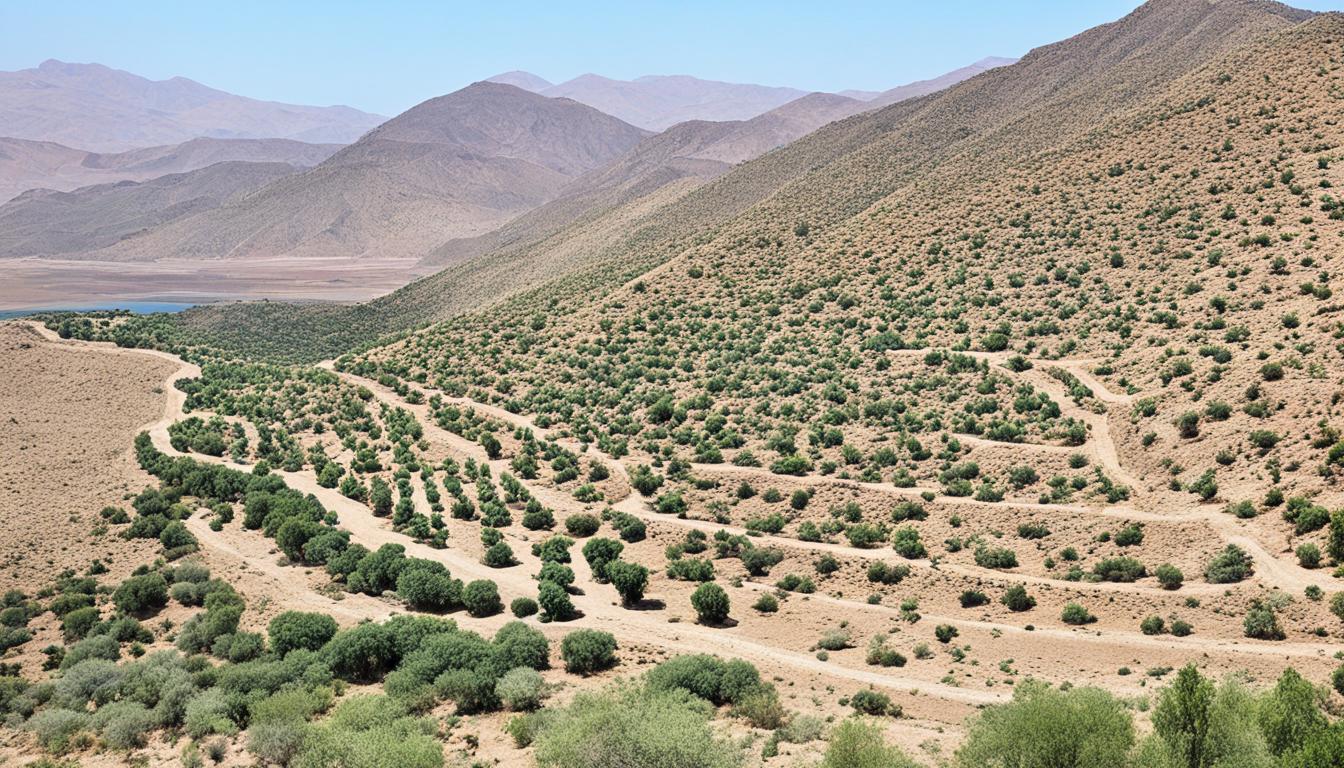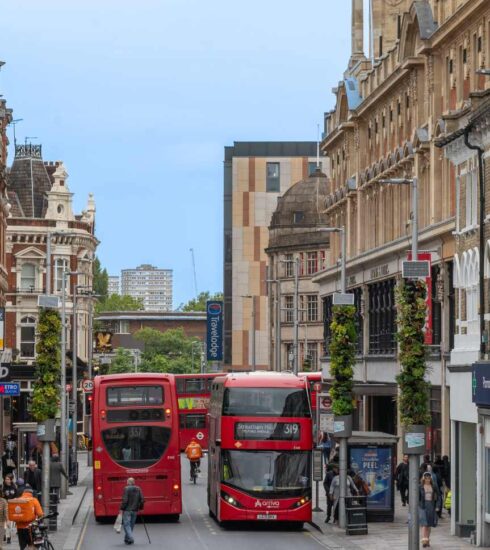Equatorial Guinea Biodiversity and the Built Environment
Did you know that Equatorial Guinea, a small country located in the Gulf of Guinea, boasts a staggering range of biodiversity? From tropical rainforests to continental rivers and islands, this nation is a haven for diverse ecosystems and wildlife. However, the rapid shift towards oil and natural gas production has posed significant challenges to the conservation of its natural resources and the sustainable development of its built environment.
Key Takeaways:
- Equatorial Guinea is known for its rich biodiversity, including tropical rainforests and diverse species.
- The country’s economy heavily depends on oil and natural gas production, leading to deforestation and negative impacts on biodiversity.
- Overhunting and habitat loss are major threats to Equatorial Guinea’s wildlife, including vulnerable primate species.
- Efforts are being made to enhance biodiversity conservation through the development of action plans and the promotion of sustainable practices.
- Equatorial Guinea is embracing eco-friendly architecture and incorporating indigenous techniques and materials in its green building projects.
Biodiversity Facts of Equatorial Guinea
Equatorial Guinea is renowned for its extraordinary biodiversity and is home to lush tropical rainforests teeming with a diverse array of species. The country is divided into distinctive biogeographic regions, encompassing both the continental mainland and enchanting islands. These unique ecosystems contribute to Equatorial Guinea’s rich biodiversity and serve as vital sources of water.
Equatorial Guinea’s continental rivers, such as the Uoro River and Muni River, provide essential lifelines to diverse plant and animal species. These rivers not only nourish the land but also support the local communities that depend on them for sustenance and livelihood.
However, the country faces significant challenges in preserving its precious ecosystems. Deforestation and habitat loss pose grave threats to Equatorial Guinea’s biodiversity. The clearing of forests, often driven by human activities such as agriculture and logging, disrupts the delicate balance of ecosystems and endangers the species that depend on them.
The diverse islands of Equatorial Guinea, including Bioko and Annobón, are home to unique species found nowhere else in the world. These isolated island ecosystems face similar threats, with habitat destruction and invasive species posing a risk to their delicate ecological balance.
Efforts are underway to protect and sustainably manage Equatorial Guinea’s biodiversity. The government is actively working to establish protected areas, such as the Monte Alén National Park and the Corisco and Elobey Chico Marine Protected Area. These protected areas serve as sanctuaries for endangered and threatened species, promoting their conservation and safeguarding their habitats.
Equatorial Guinea’s commitment to biodiversity preservation is crucial not only for the country itself but for the global community. By protecting its unique ecosystems, Equatorial Guinea contributes to the preservation of our planet’s natural heritage and ensures a sustainable future for generations to come.
Economy and Impact on Biodiversity in Equatorial Guinea
Equatorial Guinea’s economy has become heavily reliant on oil and natural gas production, resulting in negative impacts on biodiversity. The export of roundwood, although declining, still plays a significant role in the economy. Deforestation has been a major issue, with forest cover decreasing dramatically in recent years. This has had a direct impact on the 80-90% of the population that relies on forest resources for subsistence. The exploitation of forests by logging companies has further contributed to the decline in biodiversity and the threat to species such as primates.

“The economy of Equatorial Guinea has experienced a shift towards oil and natural gas, leading to a detrimental impact on biodiversity. Deforestation, driven by the exploitation of forest resources and logging activities, has been a significant concern.”
Equatorial Guinea’s economy has traditionally been based on agriculture, but the discovery of oil reserves in the 1990s transformed the country into the third-largest oil producer in sub-Saharan Africa. While the oil industry has brought economic growth and development, it has also resulted in environmental challenges.
The extraction and export of oil and natural gas have led to the destruction of habitats, pollution, and the release of greenhouse gases, contributing to climate change. This not only affects the biodiversity within Equatorial Guinea but also has global implications. The exploitation of natural resources has disrupted ecosystems and caused the loss of critical habitats for many species.
In addition to the oil industry, deforestation remains a pressing issue in Equatorial Guinea. The country’s forests are being cleared to make way for agriculture, logging, urbanization, and infrastructure development. This has a direct impact on forest-dependent communities and threatens the rich biodiversity that Equatorial Guinea is known for.
Forests in Equatorial Guinea are not only home to a wide range of plant and animal species but also provide essential ecosystem services such as carbon sequestration, water regulation, and soil conservation. The loss of forest cover reduces these services and poses risks to the resilience of ecosystems and the well-being of local communities.
The government of Equatorial Guinea recognizes the importance of addressing these challenges and has taken steps towards sustainable development and biodiversity conservation. Efforts are being made to promote responsible oil and gas extraction practices, implement reforestation programs, and strengthen conservation measures.
Promoting Sustainable Practices
Equatorial Guinea is striving to diversify its economy and reduce dependence on oil and natural gas. The government has initiated projects to encourage sustainable agriculture, eco-tourism, and renewable energy development. By promoting sustainable practices and investing in alternative industries, Equatorial Guinea aims to achieve long-term economic growth while preserving its unique biodiversity.
Protecting Forest Resources
Efforts are being made to conserve forest resources in Equatorial Guinea. The government has established protected areas and implemented legislation to regulate logging activities and curb deforestation. Forest monitoring systems and community-based initiatives are also being developed to ensure sustainable forest management and the protection of critical habitats.
Conservation and Sustainable Development
The conservation of biodiversity and the promotion of sustainable development go hand in hand. Equatorial Guinea is working towards balancing economic growth with environmental preservation. By adopting responsible practices in the oil and gas industry, implementing forest conservation measures, and supporting sustainable agriculture and renewable energy, Equatorial Guinea aims to achieve a sustainable future that benefits both the economy and the environment.
Threats to Biodiversity in Equatorial Guinea
The remarkable biodiversity of Equatorial Guinea is under threat from various factors, including overhunting, the bushmeat trade, habitat loss, and logging. These threats have serious consequences for both local ecosystems and the global conservation of endangered species.
One of the major issues is overhunting, particularly for the lucrative domestic bushmeat markets. Primates such as chimpanzees, gorillas, and monkeys are particularly vulnerable to intense poaching. Their populations are rapidly declining due to the demand for bushmeat, which puts their survival at risk.
“The unsustainable hunting and trading of bushmeat in Equatorial Guinea is driving primate species towards extinction,” warns Dr. Jane Wilson, a primatologist specializing in primate conservation in the region. “Urgent actions are needed to curb this illegal activity and protect these valuable and irreplaceable species.”
Additionally, the rampant logging activities in Equatorial Guinea result in deforestation and habitat loss, which further exacerbate the threats to biodiversity. Logging companies clear vast areas of forests, destroying crucial habitats for numerous plant and animal species.
“The logging industry in Equatorial Guinea is causing irreparable damage to our forests,” says David Mbeki, an environmental activist. “Not only does it lead to vital habitat loss, but it also disrupts the delicate balance of ecosystems and contributes to the loss of many species.”
The impact of habitat loss and deforestation extends far beyond Equatorial Guinea’s borders. The loss of these unique ecosystems disrupts regional and global biodiversity, affecting species that depend on Equatorial Guinea’s forests for their survival.
In order to protect the biodiversity of Equatorial Guinea, it is crucial to address the issues of overhunting, the bushmeat trade, habitat loss, and logging. Sustainable practices and stricter regulations need to be implemented to ensure the long-term conservation of the country’s rich natural heritage.
| Threat | Description |
|---|---|
| Overhunting | The intensive hunting of wildlife, particularly primates, for the bushmeat trade. |
| Bushmeat Trade | The illegal trade of wild animal meat, including primates. |
| Habitat Loss | The destruction of natural habitats due to deforestation and development. |
| Logging | The commercial felling of trees for timber, resulting in habitat destruction and ecosystem disruption. |
Marine Biodiversity in Equatorial Guinea
Equatorial Guinea is blessed with a diverse marine biodiversity that plays a crucial role in the livelihoods of communities engaged in artisanal fishing. The coastal waters of Equatorial Guinea are teeming with a wide range of marine species, providing valuable resources and sustenance to local fishermen and their families.
However, it is concerning to note that despite the abundance of marine life, Equatorial Guinea currently relies heavily on fish imports, with approximately 70% of the fish consumed in the country being brought in from elsewhere. This overreliance on imported fish underscores a lack of support for the local fishing industry, inhibiting its growth and economic potential.
Impacts of Climate Change
In addition to the challenges faced by the fishing industry, climate change poses a significant threat to Equatorial Guinea’s marine biodiversity. Rising sea temperatures, ocean acidification, and extreme weather events impact the delicate balance of marine ecosystems, jeopardizing the survival of numerous species.
“The conservation and sustainable management of marine resources are crucial for the future food security of Equatorial Guinea.”
It is imperative to implement community management systems that enhance the resilience of local fishing communities to the impacts of climate change. These systems can promote sustainable fishing practices, ensuring the long-term viability of the marine biodiversity and the livelihoods it supports.
Foreign Fishing Companies and Tuna Targeting
The Ministry of Fisheries and the Environment in Equatorial Guinea grants licenses to foreign fishing companies, primarily targeting tuna in the country’s waters. While these partnerships can contribute to the economy, it is essential to strike a balance between economic interests and the conservation of marine resources to preserve Equatorial Guinea’s rich biodiversity.

Importance of Conservation and Sustainability
The conservation and sustainable management of marine resources in Equatorial Guinea are critical for the future food security and economic prosperity of the country. By supporting local fisheries and implementing measures to mitigate the impacts of climate change, Equatorial Guinea can ensure the resilience and long-term viability of its marine biodiversity.
| Key Points | Actions Needed |
|---|---|
| Reduce reliance on fish imports | Invest in local fisheries and support sustainable fishing practices |
| Address the impacts of climate change | Implement community management systems and promote resilience |
| Balance economic interests and conservation | Ensure responsible licensing of foreign fishing companies |
Medicinal Plants and Traditional Medicine in Equatorial Guinea
Equatorial Guinea is renowned for its extensive use of medicinal plants and traditional medicine, which provide alternative remedies for various ailments. With over 500 plants and 100 different species being utilized, traditional medicine plays a significant role in the country’s healthcare practices.
One particularly notable plant in Equatorial Guinea’s traditional medicine is Prunus Africana. Endemic to Bioko Island, Prunus Africana is highly valued for its medicinal properties and is used to treat various conditions. It is also commercially valuable, with pharmaceutical companies overseas purchasing it for its medicinal benefits.
In addition to medicinal plants, the production and sale of ornamental plants contribute to Equatorial Guinea’s economy while also providing opportunities for sustainable livelihoods. The cultivation and trade of ornamental plants have become a thriving industry, showcasing the country’s rich diversity and enhancing its ecological sustainability.
| Medicinal Plants in Equatorial Guinea | Traditional Uses |
|---|---|
| Prunus Africana | Treatment of prostate disorders, malaria, and urinary tract infections. |
| Prunus Africana | Treatment of prostate disorders, malaria, and urinary tract infections. |
| Prunus Africana | Treatment of prostate disorders, malaria, and urinary tract infections. |
Equatorial Guinea’s commitment to preserving its medicinal plant heritage and traditional medicine systems is vital for both its cultural identity and the well-being of its population.
The Significance of Medicinal Plants in Traditional Medicine
Traditional medicine in Equatorial Guinea relies heavily on the use of medicinal plants, providing alternative remedies for various ailments. These plants have been passed down through generations and continue to play a crucial role in the country’s healthcare practices.
- Medicinal plants offer natural and sustainable treatment options.
- They provide accessible and affordable healthcare solutions.
- Traditional medicine embodies the cultural beliefs and practices of the local communities.
Equatorial Guinea recognizes the importance of preserving its medicinal plant resources and continues to promote sustainable practices in traditional medicine while integrating modern healthcare systems.
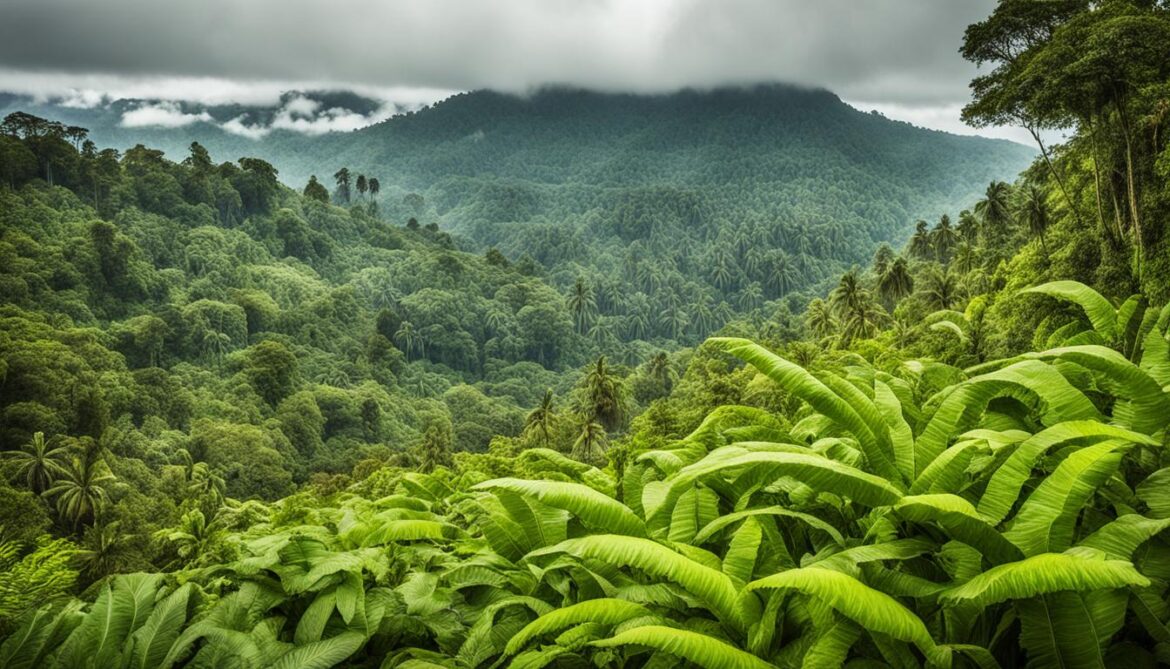
Implementation of Biodiversity Conservation Measures in Equatorial Guinea
Equatorial Guinea recognises the importance of biodiversity conservation and has taken significant steps to implement measures that safeguard its natural resources. A key initiative is the development of the National Biodiversity Strategy and Action Plan (NBSAP), which outlines comprehensive strategies and actions to preserve the country’s diverse ecosystems.
The NBSAP focuses on various areas, including:
- Institutional strengthening to enhance the capacity for effective biodiversity conservation
- Legislation development to establish legal frameworks that protect biodiversity
- Biodiversity education to raise awareness and promote sustainable practices
- Creation and management of protected areas to preserve critical habitats
- Scientific research to improve understanding and inform conservation efforts
“Equatorial Guinea has made significant progress in biodiversity conservation through the implementation of the National Biodiversity Strategy and Action Plan. This framework provides a roadmap for preserving our unique ecosystems and ensuring the long-term sustainability of our natural resources,” says Dr. Anna Ondo, Director of the Ministry of Environment and Natural Resources.
The NBSAP aims to mobilise financial resources for conservation activities, promote sectoral mainstreaming of biodiversity concerns, and explore alternative livelihood options to reduce pressure on natural resources. Legislative frameworks have been established to support biodiversity conservation, providing a legal basis for protecting ecosystems and endangered species.
“By enacting legislation that promotes biodiversity conservation, Equatorial Guinea is sending a clear message about the importance of preserving our natural heritage for future generations,” emphasizes Maria Nvono, Minister of Agriculture and Forestry.
Equatorial Guinea is also implementing environmental impact assessments (EIAs) for construction projects, ensuring that potential ecological consequences are properly assessed and mitigated. These assessments play a crucial role in promoting sustainable development and reducing adverse environmental impacts.
The government is also actively engaging with oil companies to raise awareness about sustainability issues and encourage responsible practices that minimize the impact on biodiversity and ecosystems.
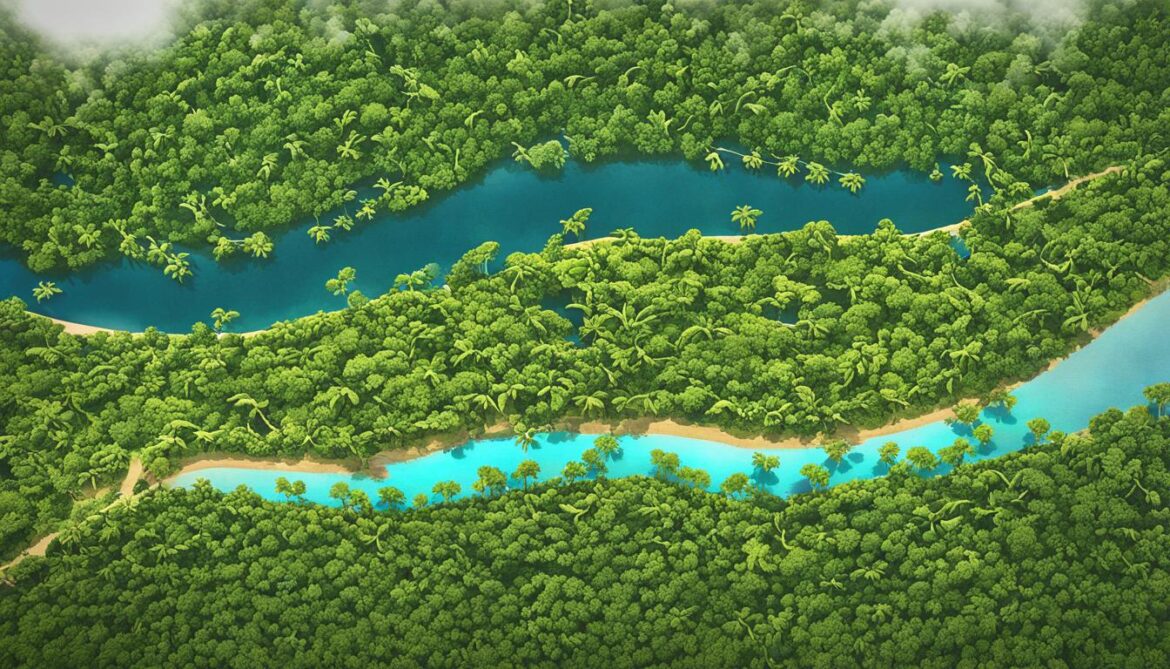
“Through our collaborative efforts with the private sector, we aim to achieve a balance between economic development and environmental preservation. By promoting sustainable practices and responsible resource management, we can create a harmonious relationship between human activities and biodiversity conservation,” highlights Dr. Pedro Obiang, Minister of Mines, Industry, and Energy.
Equatorial Guinea’s commitment to implementing biodiversity conservation measures demonstrates the nation’s dedication to preserving its natural heritage and promoting sustainable development.
Sustainable Architecture and Eco-friendly Construction in Equatorial Guinea
Equatorial Guinea has embraced sustainable architecture and eco-friendly construction practices. The country is committed to integrating environmentally friendly practices into the built environment, showcasing innovative designs, the use of sustainable materials, and indigenous construction techniques.
Notable examples of green buildings in Equatorial Guinea prioritize energy efficiency and conservation, contributing to a more sustainable future. These buildings demonstrate the country’s dedication to sustainable development and serve as inspiration for other construction projects.
The Eastgate Centre, Zimbabwe
The Eastgate Centre in Zimbabwe is an exceptional example of sustainable architecture. It utilizes a unique design that mimics natural airflow, reducing the need for air conditioning and minimizing energy consumption. The building’s ventilation system draws inspiration from the design of termite mounds, harnessing the benefits of passive cooling and energy efficiency.

The Catholic University of East Africa Learning Resource Centre, Kenya
The Catholic University of East Africa Learning Resource Centre in Kenya showcases sustainable design strategies. The building incorporates the use of sustainable materials, including locally sourced timber and recycled materials, reducing its carbon footprint. Natural lighting and advanced insulation systems contribute to energy efficiency and create a comfortable learning environment.
‘Inno-native’ Home, Ghana
The ‘Inno-native’ Home in Ghana exemplifies the integration of eco-friendly construction practices. It utilizes indigenous techniques and materials, such as adobe mud blocks and timber, combined with modern design principles. The home also features solar panels for electricity and water heating, promoting renewable energy and reducing reliance on traditional power sources.
Equatorial Guinea’s commitment to sustainable architecture and eco-friendly construction aligns with its goals of environmental preservation and long-term sustainability. These green buildings not only contribute to energy efficiency and conservation but also inspire future projects that prioritize environmental responsibility.
Energy Efficiency and Conservation in Equatorial Guinea’s Green Buildings
Equatorial Guinea’s green buildings prioritize energy efficiency and conservation, incorporating sustainable design strategies to reduce environmental impact. By utilizing natural ventilation, passive cooling, and sustainable materials, these buildings aim to create a more sustainable and energy-efficient built environment.
One notable example is the Eastgate Centre in Zimbabwe, which adopts natural ventilation techniques and indigenous masonry to reduce energy consumption by up to 90%. This innovative design allows the building to maintain a comfortable indoor temperature without relying heavily on mechanical cooling systems.
The Catholic University of East Africa Learning Resource Centre in Kenya is another inspiring green building that focuses on sustainability. Local materials, passive cooling, and natural lighting are key elements in its design, creating an environmentally friendly and energy-efficient learning environment for students.
The ‘Inno-native’ Home in Ghana is an exceptional showcase of eco-friendly materials and technologies. It incorporates sustainable construction practices such as the use of timber, adobe mud blocks, sliding slatted-wood screens, and solar panels for electricity and water heating. This combination of sustainable materials and renewable energy sources contributes to the overall energy efficiency of the building.
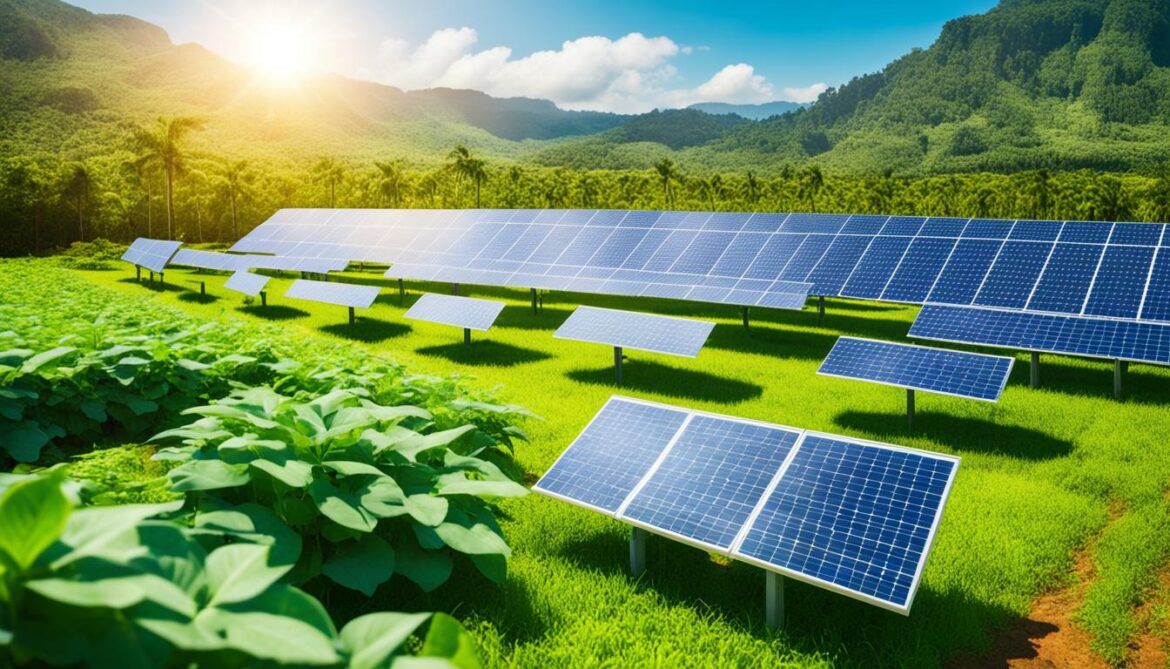
These examples demonstrate Equatorial Guinea’s commitment to energy efficiency and conservation in the construction sector. By integrating sustainable design principles and renewable energy technologies, green buildings in Equatorial Guinea are paving the way for a more sustainable future.
| Green Building | Energy Efficiency Features |
|---|---|
| Eastgate Centre, Zimbabwe | Natural ventilation, indigenous masonry |
| Catholic University of East Africa Learning Resource Centre, Kenya | Local materials, passive cooling, natural lighting |
| ‘Inno-native’ Home, Ghana | Eco-friendly materials, timber, adobe mud blocks, sliding slatted-wood screens, solar panels |
Indigenous Techniques and Materials in Equatorial Guinea’s Green Buildings
Equatorial Guinea’s green buildings prioritize the use of indigenous techniques and materials, contributing to sustainable construction practices while preserving the region’s cultural heritage. By integrating traditional knowledge and sustainable approaches, these buildings showcase the unique identity of the local communities and their commitment to environmental preservation.
The Eastgate Centre
The Eastgate Centre in Zimbabwe exemplifies the successful application of indigenous techniques in green construction. Indigenous masonry, characterized by locally sourced materials and traditional building methods, reduces the ecological impact of the building process and contributes to energy efficiency. Coupled with natural ventilation systems inspired by termite mounds, the Eastgate Centre significantly reduces energy consumption and has become a prominent model for sustainable architecture in Africa.
The ‘Inno-native’ Home
The ‘Inno-native’ Home in Ghana demonstrates the integration of traditional building materials and modern design principles. By incorporating elements such as timber and adobe mud blocks, the home showcases sustainable practices while showcasing the cultural roots and traditions of the community. This unique combination of local materials and contemporary aesthetics creates a harmonious blend of tradition and modernity, promoting eco-friendly construction in Equatorial Guinea.
These examples highlight the importance of preserving and integrating indigenous techniques and materials in building projects. By valuing and utilizing local resources, Equatorial Guinea’s green buildings not only promote sustainable practices but also contribute to the preservation of cultural heritage, reinforcing the country’s commitment to environmental sustainability.
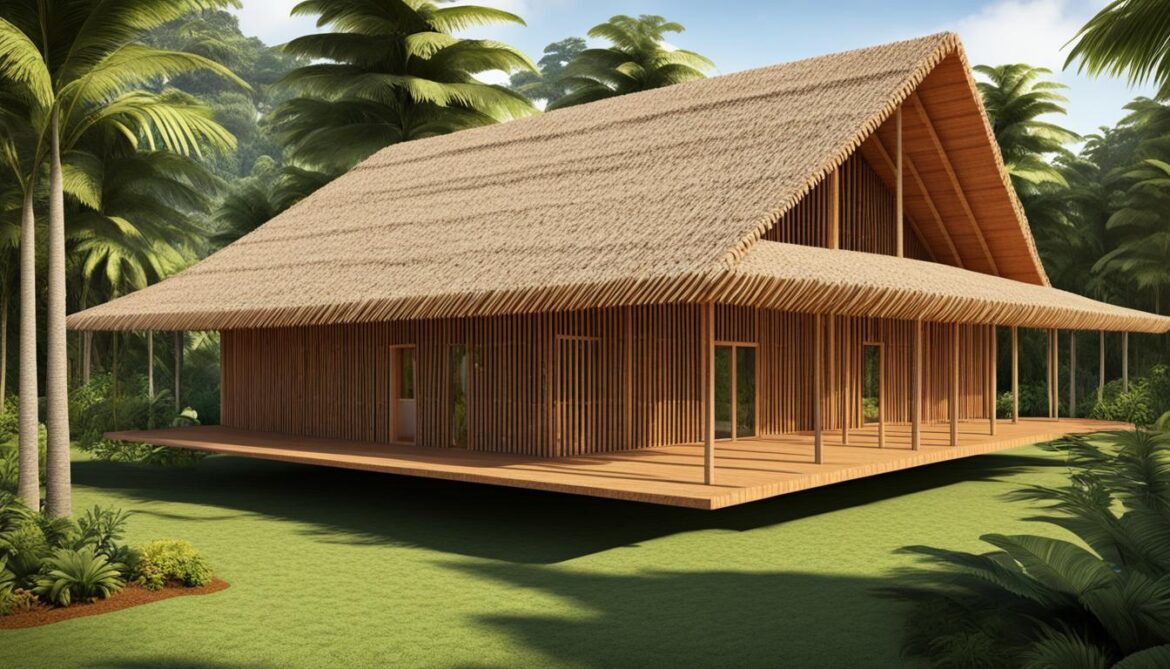
Key Benefits of Indigenous Techniques and Materials in Green Buildings:
- Promote sustainability and environmental preservation
- Preserve cultural heritage and traditional knowledge
- Reduce ecological footprint through the use of locally sourced materials
- Enhance energy efficiency and reduce energy consumption
- Create a unique architectural identity that reflects the local community
Inspiring Examples of Sustainable Architecture in Africa
Equatorial Guinea is not the only African country leading the way in sustainable architecture and eco-friendly construction. Various countries in Africa have inspiring examples of green buildings that prioritize sustainability and innovative design. These projects showcase the continent’s commitment to sustainable development and serve as inspiration for future construction projects.
Eastgate Centre, Zimbabwe
The Eastgate Centre in Zimbabwe is a prime example of sustainable architecture in Africa. Designed by architect Mick Pearce, this building takes inspiration from termite mounds to create an energy-efficient structure. The building utilizes natural ventilation and a passive cooling system, significantly reducing energy consumption. By mimicking the termite mound’s ability to regulate temperature, the Eastgate Centre saves on air conditioning costs and has become a symbol of sustainable design in Africa.
Catholic University of East Africa Learning Resource Centre, Kenya
The Catholic University of East Africa Learning Resource Centre in Kenya is another notable example of sustainable architecture. The building incorporates sustainable materials and local craftsmanship to create a harmonious blend of tradition and innovation. Natural lighting and passive cooling techniques are used to reduce the building’s energy consumption, while solar panels provide clean electricity. The design of the center promotes a sustainable learning environment, emphasizing the importance of sustainability in education.
‘Inno-native’ Home, Ghana
The ‘Inno-native’ Home in Ghana showcases the integration of indigenous techniques and sustainable construction. The design incorporates traditional building materials such as timber and adobe mud blocks, creating a visually appealing and environmentally friendly structure. Sliding slatted-wood screens allow for natural ventilation and daylighting, reducing the need for artificial lighting and cooling. The inclusion of solar panels for electricity and water heating further enhances the home’s eco-friendly features.
| Project Name | Country | Sustainable Features |
|---|---|---|
| Eastgate Centre | Zimbabwe | Natural ventilation, passive cooling |
| Catholic University of East Africa Learning Resource Centre | Kenya | Sustainable materials, solar panels, passive cooling |
| ‘Inno-native’ Home | Ghana | Indigenous techniques, timber, adobe mud blocks, solar panels |
These inspiring examples of sustainable architecture in Africa highlight the importance of incorporating sustainable design principles in the construction industry. By prioritizing eco-friendly construction practices, African countries are setting an example for sustainable development worldwide.
Conclusion
Equatorial Guinea’s biodiversity and the built environment are intricately linked, highlighting the importance of sustainable development in preserving the country’s natural resources. The conservation of biodiversity is crucial for the well-being of both ecosystems and human populations, and Equatorial Guinea is taking significant steps to enhance biodiversity conservation.
Through the development of National Biodiversity Strategy and Action Plans and the promotion of sustainable practices across various sectors, Equatorial Guinea is actively working towards preserving its unique ecological heritage. The country serves as an inspiring example of the integration of sustainable architecture and eco-friendly construction, prioritizing energy efficiency, and the use of indigenous techniques and materials.
By prioritizing biodiversity conservation and sustainable development, Equatorial Guinea is paving the way for a greener and more sustainable future. As the country continues to protect its diverse ecosystems and embrace eco-friendly construction, it sets an important precedent for other nations to follow, emphasizing the significance of environmental preservation in the face of global challenges.
FAQ
What is Equatorial Guinea Biodiversity and the Built Environment?
Equatorial Guinea Biodiversity and the Built Environment refers to the study and conservation efforts focused on preserving the country’s rich biodiversity while implementing sustainable development practices in construction and urban planning.
What are some facts about the biodiversity in Equatorial Guinea?
Equatorial Guinea boasts tropical rainforests and diverse ecosystems spread across its continental and insular biogeographic regions, which are sustained by continental rivers and islands.
How does the economy of Equatorial Guinea impact biodiversity?
The economy of Equatorial Guinea heavily relies on oil and natural gas production, which has led to deforestation and habitat loss, negatively affecting biodiversity. The exploitation of forest resources has also had a significant impact on the local population.
What are the main threats to biodiversity in Equatorial Guinea?
Overhunting, the bushmeat trade, habitat loss, and logging activities are major threats to biodiversity in Equatorial Guinea. These activities endanger primate species and contribute to the global conservation challenge.
How does Equatorial Guinea approach marine biodiversity?
Equatorial Guinea’s marine biodiversity plays a crucial role in the livelihoods of communities engaged in artisanal fishing. However, the country currently relies on fish imports, which calls for the need to promote sustainable fishing practices and strengthen resilience to climate change impacts.
What is the significance of medicinal plants and traditional medicine in Equatorial Guinea?
Equatorial Guinea has a rich tradition of using medicinal plants in traditional medicine, with over 500 plants and 100 species employed to provide alternative remedies. Plants such as Prunus Africana have both traditional medicinal uses and commercial value.
What measures has Equatorial Guinea taken to conserve biodiversity?
Equatorial Guinea has developed a National Biodiversity Strategy and Action Plan (NBSAP) to enhance biodiversity conservation. The country has also implemented legislative frameworks, protected areas, and environmental impact assessments for construction projects, while raising awareness among oil companies about sustainability issues.
What are some examples of sustainable architecture and eco-friendly construction in Equatorial Guinea?
Equatorial Guinea has notable green buildings, including the Eastgate Centre in Zimbabwe and the Catholic University of East Africa Learning Resource Centre in Kenya. These buildings prioritize energy efficiency, passive cooling, and the use of sustainable materials.
How do green buildings in Equatorial Guinea prioritize energy efficiency and conservation?
Equatorial Guinea’s green buildings incorporate strategies such as natural ventilation, passive cooling, and the use of sustainable materials to reduce energy consumption. The Eastgate Centre in Zimbabwe, for example, utilizes indigenous masonry and natural ventilation to achieve significant energy savings.
What role do indigenous techniques and materials play in Equatorial Guinea’s green buildings?
Equatorial Guinea’s green buildings prioritize the use of indigenous techniques and materials, allowing for sustainable construction practices that preserve the cultural heritage of the region. Examples include the ‘Inno-native’ Home in Ghana, which combines traditional materials with modern design.
Are there inspiring examples of sustainable architecture in other African countries?
Yes, various African countries have impressive examples of sustainable architecture and eco-friendly construction. Notable projects include the Eastgate Centre in Zimbabwe, the Catholic University of East Africa Learning Resource Centre in Kenya, and the ‘Inno-native’ Home in Ghana.



